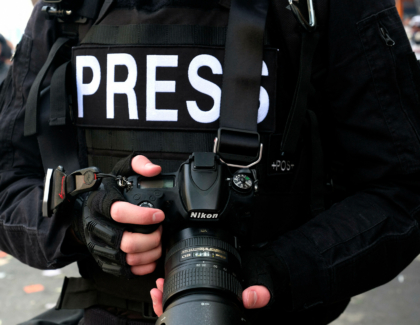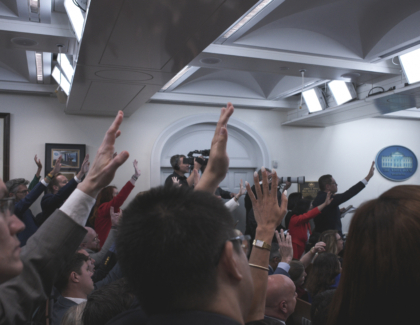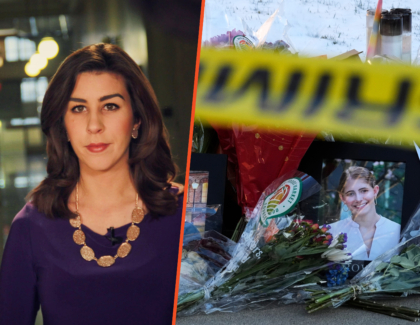Sign up for the daily CJR newsletter.
In April, the Daily Beast reported that Donald Trump periodically makes an observation about the press: when, from time to time, he softens his tone and conduct, the media will notice and praise him for it. “It’s so easy, can you believe it?” Trump said at a dinner in 2017, after seeing a positive turn in coverage. “All I had to do was be a little nice.” On the occasions Trump acts relatively less obscene, reporters and pundits tend to credit him with a “pivot”; they’ll also make a point of trying to anticipate “pivots”—usually by noting that his advisers have briefed him, ahead of a big speech, to be good, for once. That happened in July, when Trump reinstated his coronavirus briefings. (They had previously been canceled after he told Americans to inject bleach.) And it happened again yesterday, before what should have been Trump and Joe Biden’s third debate of the cycle, but was actually their second, since Trump bailed on one of them. “Will President Trump dial back his aggression?” the New York Times asked. NBC framed the question differently: “A new tone for Trump?”
Sure enough, Trump behaved marginally more respectable than he did during the first debate—which, you will recall, he single-handedly derailed—and won media plaudits. Tim Alberta, of Politico, suggested that the president had “recalibrated his entire approach”; David French, of The Dispatch and Time, wrote that “the different tone is astonishing”; Amy Walter, of the Cook Political Report and The Takeaway, called Trump “very disciplined” and wondered if he can keep it up through election day. Staffers at CNN, the Times, and ABC agreed that Trump was “disciplined,” at least comparatively so; Axios concurred, too, in an article headlined, “Finally, a real debate.” The Times noted that Trump’s better behavior didn’t last all evening, but that he “succeeded” insofar as he “spoke with an inside voice” and “thanked the moderator for letting him chime in and did not sound sarcastic while doing so.”
New from CJR: How the press covered the last four years of Trump
Did we actually get a “real debate”? There were some positives. The moderator—NBC’s Kristen Welker, who became the first Black woman to moderate a debate between presidential nominees since 1992—did better than Chris Wallace, who moderated the first debate of this cycle, and Susan Page, who moderated the subsequent vice-presidential debate. (Welker was aided, in part, by the debate commission’s decision to mute the candidates’ mics for portions of the evening—a bid to limit interruptions that might have helped Wallace, in particular.) Welker pushed Trump repeatedly on how he plans to reunite the migrant families that his administration separated; asked a sharp question about The Talk that Black parents must have with their children about police violence; dedicated an entire segment of the debate to climate change; and asked about environmental racism. Some of these questions elicited instructive (or at least revealing) answers from the candidates. But Welker also wasted time on a question about the foreign business dealings of Hunter Biden, Joe’s son, that was, predictably, grist for Trump’s new favorite talking point. (There was no such question about the dodgy conduct of Trump’s children.) And she failed to push back on many obvious Trump lies. Daniel Dale, the CNN fact-checker, observed at one point that Trump was lying “even worse” than during the first debate. So much for discipline.
As the New Republic’s Alex Shephard put it, Trump didn’t “foam at the mouth” last night, but “his performance was still pathological… a vicious cavalcade of dishonor and dishonesty.” Analyzing Trump’s debate style without taking into account the substance of what he said, Shephard wrote, is a fool’s errand, since the two are inseparable; that Trump “delivered his lines with a comparative quietude was just part of the lie.” Many members of the political press can’t—or don’t want to—see this inseparability; they’re much more comfortable focusing on optics, and leaving substance to the side. That isn’t a Trump-era development in political journalism; it’s much older. Still, there’s no doubt that Trump has lowered the bar by which judgments are rendered—only he could turn in a performance as fraudulent and incoherent as last night’s and come out smelling, if not of roses, then at least comparatively clean to many a pundit’s nose. Pod Save America’s Jon Favreau tweeted that the idea of Trump being disciplined may reflect a kind of “Stockholm Syndrome” on the part of those who cover him. It may also reflect our desperation to find something new to say.
When it comes to the presidential election, there is a lot that needs to be said on a range of important topics, but, as I wrote earlier this week, much campaign coverage seems determined, instead, to go around in circles with empty speculation and inane observations. The separation of migrant families is a case in point. The fact that more than five-hundred migrant children are still detached from their parents inspired a lot of coverage this week, but many of those stories failed to connect the stakes to the election, even though the Trump administration’s cruelty is manifestly an election story, as well as a human-rights one. Last night, Welker asked about Trump’s policy of separating families at the border, but her question got lost, in much post-debate punditry, amid the “new tone” froth. The good news is that the debates are now over, so there’s no primetime event to distract journalists from discussing the stuff that matters. In theory, at any rate. We may choose to keep wasting time on Trump’s “pivots.”
Below, more on the election:
- 60 Minutes: This week, Trump stormed out of a pre-taped interview with Lesley Stahl, of 60 Minutes. He subsequently threatened, as some kind of “gotcha,” to release White House footage of the interview ahead of its planned broadcast this Sunday; yesterday, he followed through—sharing footage that showed Trump bridling at Stahl’s perfectly-fair questions. CBS News said that the White House’s decision to post its footage online violated a promise to only record the interview for archival purposes.
- Hunter Biden: Yesterday, the Wall Street Journal’s opinion and news pages published contrasting articles about Hunter Biden. In an op-ed, Kimberley A. Strassel, a member of the Journal’s editorial board, suggested, based on information provided by Tony Bobulinski, a former business partner of Hunter Biden, that Joe Biden was involved in Hunter’s dealings in China—but two Journal news reporters, Andrew Duehren and James T. Areddy, subsequently reported that records they obtained from Bobulinski “don’t show either Hunter Biden or James Biden [Joe’s brother] discussing a role for Joe Biden in the venture.” Variety’s Gene Maddaus observes that the conflicting takeaways reflect “ongoing tension” between the news and opinion sides of the Journal; in July, more than two-hundred Journal staffers wrote to the paper’s publisher accusing the opinion side of a “lack of fact-checking and transparency,” and an “apparent disregard for evidence.”
- The vote: An investigation by VICE found that since 2016, nearly 21,000 Election Day polling locations have closed, for reasons including “a heavy shift to mail voting, coronavirus-related consolidations, cost-cutting measures, and voter suppression.” The trend, VICE’s Cameron Joseph and Rob Arthur report, “could disproportionately impact poor, young and non-white voters.”
- Covers: For the first time in its history, Time magazine removed its name from the top of its cover; it replaced the name with the word “VOTE,” styled like the Time logo. Elsewhere, New York magazine previewed its next covers: there will be four of them, and each will feature twelve “I VOTED” stickers designed by artists including David Hammons, Laurie Simmons, and Amy Sherald. New York will distribute 500,000 of the stickers at bookstores and museums nationwide.
Other notable stories:
- For CJR, I worked with Pete Vernon—who wrote this newsletter until I took it over, in October 2018—to review the debates, narratives, and missteps that have defined media coverage of Trump’s presidency. We re-read every newsletter we’ve written since January 2017, and concluded that the “basic practices and rhythms” of coverage have “conspired, time and again, to downplay demagoguery, let Trump and his defenders off the hook, and drain resources and attention from crucial longer-term storylines.”
- Yesterday, following a long period of pressure, a federal court released the transcript of a deposition given—as part of a defamation case, in 2016—by Ghislaine Maxwell, a Jeffrey Epstein associate who was arrested in July on child sexual-abuse charges. (She has denied wrongdoing.) The court redacted the names of powerful men, including Bill Clinton and Prince Andrew, who had dealings with Epstein—but Slate was able to decode the redactions using an alphabetized index that appeared in the transcript.
- On Wednesday night, Fox’s Tucker Carlson and a guest on his show—Darren Beattie, a former Trump speechwriter—attacked Brandy Zadrozny, who covers the Internet and disinformation for NBC News, for doing journalism. Yesterday, NBC hit back, noting that by “smearing” Zadrozny, Fox had “shamefully encouraged harassment and worse.” Later, Zadrozny and her colleague Ben Collins published a story tracking how wild conspiracy theories about Hunter Biden have spread online, including via a pro-Trump site linked to Beattie.
- As Mark Hertsgaard has written, for CJR and The Nation’s Covering Climate Now project, Trump’s nomination of Amy Coney Barrett to the Supreme Court is an important climate story, given her apparent anti-regulation views—but her climate stance has mostly passed under the radar, especially on TV. Evlondo Cooper, of Media Matters for America, reviewed 264 cable-news segments that aired during Barrett’s confirmation hearings. Just thirteen of them mentioned climate change or the environment.
- In June, the New York Daily News fired Anna Sanders, a City Hall reporter, on the grounds, Sanders says, that she revealed confidential personnel information. Now Sanders is suing the paper; its editor in chief, Robert York; and its owner, Tribune Publishing. She alleges that she was wrongfully dismissed for questioning why a male colleague earned more than she did. Katie Robertson has more for the Times.
- For CJR and the Tow Center’s Journalism Crisis Project, Lauren Harris examines the toll that the media industry’s long-term financial decline has taken on journalists. “Like a frog boiled slowly, we’ve allowed ourselves to adjust to the calamity, again and again,” Harris writes. “But emphasizing survival over dwindling capacity hurts the industry, and hurts the people who keep it alive.” (To subscribe to her weekly newsletter, click here.)
- This week, the graduate journalism school at the University of California, Berkeley, appointed Geeta Anand as its dean; she will be the first woman to fill the post. Anand, who had been serving as interim dean, started teaching at the school in 2018. She previously worked as an India correspondent for the Times and the Journal.
- And Wired’s Kate Knibbs has a great profile of ClickHole, a humor site that “just isn’t as relevant as it used to be” given that many of its jokes still rely on the “outdated viral headline formulations of a decade ago.” ClickHole has financial troubles, too. In February, Cards Against Humanity acquired the site, then transferred majority ownership to ClickHole staff. That looked like a “digital media fairy tale”—but then came the pandemic.
ICYMI: The Google case is a stew of technology, law, and politics
Has America ever needed a media defender more than now? Help us by joining CJR today.







